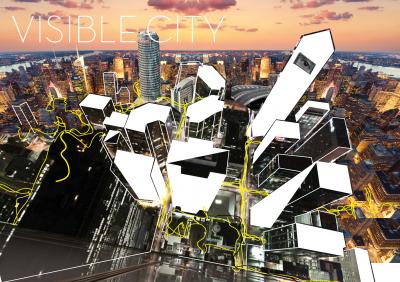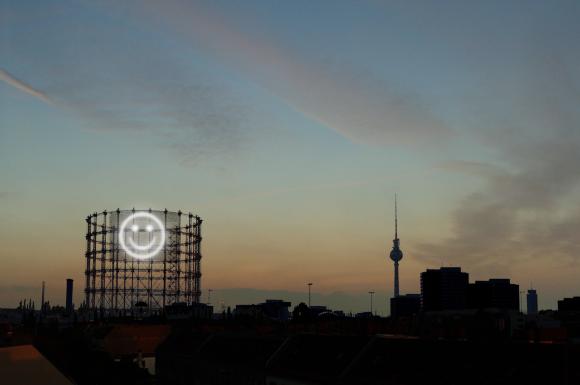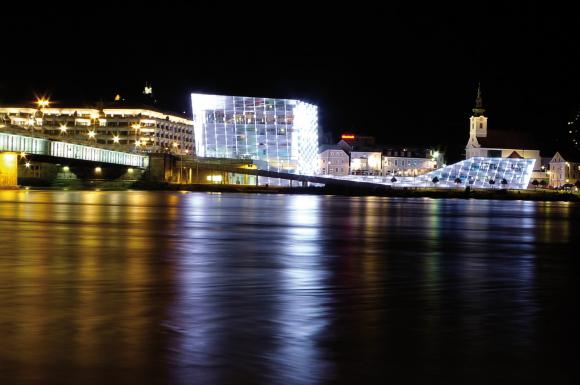Visible City 2015
Societal flows and processes become analysed and visualised on urban media facades through using data which is generated by digital sensor networks and infrastructures that underlie our daily lives.
Challenging questions:
How can we make social, environmental and intercultural processes visible and use the screens as black boards and visualization zones? What is the impact on the society, when invisible structures that underlie our daily life get visualised? What is the potential to create public awareness?
Photograph:
Mood Gasometer by Julius von Bismarck, Benjamin Maus and Richard Wilhelmer, Media Facades Festival Europe 2010
City Sleep Light by Antoine Schmitt, Media Facades Festival Europe 2010
Video:
Editing by Ludwig Reuter, material by Ludwig Reuter, Xar Lee & Jana Mörmann
CALL FOR PROPOSAL FOR THE VISIBLE CITY 2015
BERLIN - BRUSSELS - HELSINKI - LINZ -LIVERPOOL - MADRID - MARSEILLE - MONTREAL - SAO PAULO -Z AGREB
Our today's modern cities are hybrid structures in which technology is invisibly interweaved in the perception layers of our everyday lives. With the curatorial theme of InVISIBLE and VISIBLE Cities we want to develop an awareness on the changes which are hardly visible to the eyes and are underlying our nowadays cities.
 We call for artistic scenarios to visualise invisible, embedded 'smart' urban infrastructures and analyse their impact on the technological transformation of our society in a broad and public discourse.
We call for artistic scenarios to visualise invisible, embedded 'smart' urban infrastructures and analyse their impact on the technological transformation of our society in a broad and public discourse.
Please submit your project proposal until 31 October, 2014 here: http://medialab-prado.es/article/invisibleandvisiblecities2015
For more detailed information about the call, please see below!
More detailed Information
CALL FOR PROPOSALS: IN/VISIBLE CITY 2014
In 1972 Italo Calvino wrote about his Invisible Cities a romantic love poem to the city, which has the variety and liveliness of overlapping stories and interdependences in it. Our today's modern cities are hybrid structures in which technology is invisibly interweaved in the perception layers of our everyday lives. These cities produce real-time urban data and introduce control mechanism. In a state of digitalisation, between surveillance and data collection, we look out for a tangible manifestation of immaterial structures.
Curatorial Theme
With the curatorial theme of InVISIBLE and VISIBLE Cities we want to develop an awareness on the changes which are hardly visible to the eyes and are underlying our nowadays cities.
The In/Visible City perspective aims to rethink the debate of visible versus invisible without falling in the trap of focusing on new gimmicks at the expense of content, where drones or QRcodes, VR, phone apps, GPS, Kinect, EEG interfaces, large urban displays, become the core of a discourse, which goes much further beyond its technological surface.
We call for artistic scenarios to visualise invisible, embedded 'smart' urban infrastructures and analyse their impact on the technological transformation of our society in a broad and public discourse. Open or hidden data should be provided a visible layer beyond the aesthetics of data visualisation. Different positions frame this discussion of our future cities within the urban challenges i.e. of climate change, energy consumption and transport systems. We want to approach the In/Visible City through these three main questions:
Hybrid Cities: How can we read and interact with the urban space and which stories / processes are hidden within?
Digital Citizenship: How can citizen shape their digital urban environment and find new strategies for active / critical data collection processes and citizen's engagement?
Translocal Connectivity: How can we act physically in one place but mentally / emotionally appear in a different place through interactive urban scenarios and various interfaces?
The aim is not to represent reality, but to make a transformative/critical proposal with the question: Beside enhancing and optimizing (Smart City), empowering and improving (‘open source urbanism’), do we also want to explore other approaches, maybe less "useful" but as meaningful; more poetic, narrative, contemplative or situationist? The call wants to encourage projects that reveal new levels of perception to an invisible layer of our nowadays cities.
The In/Visible City 2015 will take place in Berlin, Brussels, Helsinki, Linz, Liverpool, Madrid, Marseille, Montreal and São Paulo and Zagreb. The Connecting Cities infrastructure to be considered by the artists for this Call for Proposals corresponds to the permanent and temporary urban media infrastructures of these cities (see www.connectingcities.net/infrastructure). Nevertheless we also welcome proposals directed to other partner cities of the Connecting Cities Network. We will forward these proposals to the partner cities who might then decide to join our 2015 Connecting Cities Events.
More information
Download this document or go to www.connectingcities.net for more information about the Connecting Cities Network. We advise you to have a look at the artworks that were selected for Networked City 2013 and Participatory City 2014. You can find more information about the urban media facades and venues of the Connecting Cities Events at www.connectingcities.net/infrastructure. If you have any further questions, please send an email to contact(at)connectingcities.net
Submission Deadline
Please submit your project proposal until 31. October 2014, CET 23:59h on http://medialab-prado.es/article/invisibleandvisiblecities2015.
Criteria for Selection
// Areas for the Visible City
· Reflecting the role of agents/human beings in surveilled public space
· Data between fear and opportunity
· To demonstrate or deny a political position in data as to reflect descriptiveness
· Providing a critical artistic perspective towards data visualisation
· Rethinking institutional infrastructures
· Invisibility as a citizen practice
· Surveillance vs. Connectedness
· If projects want to "create change", they have to explain the role of the visualization in that process (the visualization for example acts as an exchange platform).
· Cooperations with students/institutions (educating systems), community relationships
Technological Issues
An urban media artwork that…
- takes into consideration all technological aspects (resolution, size, daylight compatibility, content management systems, internet connectivity, site specificity etc.) of the Connecting Cities infrastructure in at least one of the participating partner cities (Berlin, Brussels, Helsinki, Linz, Liverpool, Madrid, Marseille, Montreal, Riga, São Paulo, Zagreb). Details about the CCN infrastructure in each city can be found at www.connectingcities.net/infrastructure.
- provides the technological possibility of a networked scenario in which it connects at least two participating cities
- possibly uses locative commons and open source software that encourage community knowledge sharing
- possibly facilitates alternative encounters with the public space through innovative interfaces like motion tracking, data visualisation processing, semantic web, mobile and embodied interaction interfaces, streaming technologies, etc.
FORESEEN ACTIVITIES – IN/VISIBLE CITY 2015
In/Visible City Special Artists’ Activity: Connecting Cities Lab & Residency 2015
- Artist Workshop / Prototyping Lab at Public Art Lab, Berlin during transmediale, in January 2015
- Connecting Cities Research Residency 2015 à 30 days at Public Art Lab, Berlin; Ars Electronica, Linz; FACT, Liverpool in Spring 2015.
Presentation of the Selected Projects: Connecting Cities Events 2015
- Connecting Cities Events in Berlin, Brussels, Helsinki, Linz, Liverpool, Madrid, Marseille, Montreal, Riga, São Paulo, Zagreb throughout the year 2015.
- Connecting Cities Conference at Ars Electronica, Linz in September 2015
CALL FOR PROPOSAL / PROCEDURE
Selection of the artists’ works
Artists should justify why the project needs to be displayed in urban screens in the urban space, instead of mobile apps, although mobile application can be an extended format to the digital large screens.
Selection results
During the Curators Workshop, Aarhus in November 2014 the artist proposals will be discussed.
The selection will be published in December 2014.
Curators of the Connecting Cities Network (CCN) for 2015
Susa Pop (Initiator of CCN, Public Art Lab, Berlin), Mike Stubbs (FACT, Liverpool), Christopher Lindinger (Ars Electronica, Linz), Yves Bernard (iMAL, Brussels), Céline Jouenne (Videospread, Marseille), Nerea Calvillo (Medialab-Prado), Minna Tarkka (m-cult, Helsinki), Gernot Tscherteu (Media Architecture Institute, Vienna), Darko Fritz (MSU Zagreb), Alain Mongeau (MUTEK, Montreal), Martin Brynskov (University of Aarhus), Marilia Pasculi (Verve Cultural, Sao Paulo), Pascal Lefebvre (Quartier des spectacles, Montreal)
Fee and Production Budget
Artist Fee: 1.500 €
Production Cost: 3.000€
Per selected artists’ project (not per artist)
About the Connecting Cities Network
The Connecting Cities Network (CCN) is initiated by Public Art Lab Berlin and involves 22 international partners in 20 cities:
Aarhus – Aarhus University
Berlin – Public Art Lab
Brussels – iMAL
Dessau – Foundation Bauhaus Dessau
Helsinki – m-cult
Istanbul – Amber Platform
Linz – Ars Electronica
Liverpool – FACT
Madrid – Medialab-Prado
Marseille – Videospread, Marseille-Provence 2013
Melbourne – Federation Square
Montreal – MUTEK, Quartier des Spectacles
Riga – Riga 2014
Sao Paulo – Verve Cultural
Sapporo – Media Arts Lab
Sydney – The Concourse
Vienna – Media Architecture Institute
Wuhan – 403 International Arts Center
Zaragoza – ETOPIA
Zagreb – Museum of Contemporary Art
Streaming Partner: Streampark
Media Partner: Arte Creative
Connecting Cities focuses on networked urban screens as a medium to establish a trans-local infrastructure for the citizens to encounter the public space across a coextensive dimension that connects online and offline layers, local neighbourhoods and cosmopolitan European clusters. As a paradigmatic feature in dynamics of urban corporatisation, big screens and animated surfaces in the public space are an extremely relevant factor in the cultural and social exploration of the city.
We will investigate this creative potential within a 4-years artistic research programme that combines workshops and conferences with the production of artworks and other artistic activities, leading to several Connecting Cities Events. During these events, the participating cities will be connected in an intercultural real-time exchange where a broad public audience can interact with the produced artworks. The Connecting Cities Events follow three curatorial topics that are also of social relevance:
Networked City 2013 opens urban media facades as real-time windows between the cities and connects local neighbourhoods beyond national borders.
Participatory City 2014 engages the citizens in the collaborative creation of their urban environment and encourages them to use urban media facades as a digital stage to directly communicate and debate in the public space.
Visible City 2015 visualises open data generated through sensor and data networks on urban media facades and creates awareness of the environment.
Online submission form: http://medialab-prado.es/article/invisibleandvisiblecities2015


